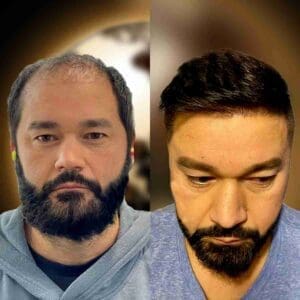Over the past two decades, transplanting hair has gone from a fringe surgery with varying results to a standardized and highly popular treatment offering a more natural look. However, people are always curious about the success rate, as it is a considerable investment of their time and money, even with the lower prices offered by Turkish clinics like Asli Tarkan.
We will go over the basics to show which methods are used, how they work, and the kind of results you can expect if you pick an experienced surgeon and follow the prescribed post-op checklist.
Are Modern Hair Transplants an Effective Procedure?
These operations use the patient’s own healthy hair from an area that is the most resistant to balding – the back of the head and neck – where the strands remain strong and healthy, even in the later, more severe stages of male pattern baldness.
That’s why the process is smooth and involves minimal risks, allowing for a greater chance of successful hair implantation and better results. When the procedure is performed by a skilled surgeon, around 95% of the donor hair will remain within a year of the surgery.
The final results are quite impressive, as you get plenty of thickness and youthful, but realistic hairline.
What Is the Success Rate of Hair Transplants?
How many of the tens of thousands of procedures performed in the last decade have been a complete success? Quite a large number, actually, as modern methods and the tools used allow doctors to preserve grafts and ensure optimal healing.
The success rate of hair transplant surgeries in state-of-the-art clinics is as high as 98%, using the latest techniques that we will now describe in more detail.

How Does a Hair Transplant Work and What are the Different Types of Procedures?
There are three main methods used today, although the first one is far less popular due to the impressive results offered by the other two. Here is a brief overview.
Follicular Unit Transplantation, FUT
This is an older type of hair transplant surgery where a strip of skin was taken from the back of the head, then broken down into individual grafts, which were implanted into the recipient area. While highly successful, with 90% of follicles surviving and taking root, it left a large scar in the donor area and led to a thinner and patchier look.
Follicular Unit Extraction, FUE
Here, the hair follicles are taken out of the donor site one by one and preserved in a petri dish with a special solution. Then, microscopic incisions are made in the bald parts of the scalp with either a steel or artificial sapphire blade, where the hair is implanted. This leads to minimal scarring and precise placement, allowing for faster healing and a fuller, denser look.
Direct Hair Implantation, DHI
This is a variation of the FUE hair transplant. The hair grafts are extracted in the same way, using a micromotor punch, but they are then loaded directly into a specialized tool called the Chi Pen. This instrument has a hollow needle-like protrusion, which allows surgeons to simultaneously create a micro incision and place the graft.
The operation is shorter than with other methods, and the doctor can achieve denser placement for more natural-looking results. There is also a no-shave option, where the rest of the hair in the donor and recipient area can be left intact, which is particularly popular with women.
The latest Robotic DHI speeds things up even further, lasting only 50% as long as the traditional version, and the follicles inside the Choi Pens are exposed to UV light and receive a PRP treatment as they pass through the machine. This reduces the risk of infection and improves graft survivability, and the patient doesn’t have to receive additional PRP sessions after the surgery.
The Recovery Timeline
The first four days after surgery will be critical, as you will have to protect your scalp and avoid washing it. You can then wash your head lightly, pouring lukewarm water over it and letting it dry on its own.
After two weeks, the donor hair will be fully secure, and the scabs formed after the operation should fall off on their own. In the first few months, thin hairs will grow and then fall out, which is a normal part of the process, and you will need to take the prescribed medication and apply the products provided by the clinic.
You will see the full results in about one year after the surgery.
How Much Does a Surgeon’s Skill Affect the Outcome of the Hair Transplant Procedure?
he final result will greatly depend on the skill and experience of the doctor, as precision is crucial. They have to be careful not to damage the follicles during extraction, which also have to be preserved properly, and to properly place them during implantation to follow the natural direction of hair growth.
This is especially important when dealing with treatments for the Afro hair type, as the tightly coiled structure extends into the root and can be damaged more easily.
A good surgeon will not only ensure a higher success rate of hair transplants but also create a more aesthetic look and provide advice on the proper post-operative care. You will also get all the necessary medication, hair care products, and a neck pillow as part of the all-inclusive package at reputable clinics like Asli Tarcan.
All these factors will contribute to the ultimate success of the procedure, so it really is best to find a top surgeon who will know exactly how to take care of your unique needs.
An Overview of Hair Transplant Statistics
In most cases, as long as you choose a highly rated clinic, you have nothing to worry about. With the latest equipment and a steady, experienced hand performing the surgery, around 90% to 95% of donor grafts will survive and take root. With a hair transplant success rate of up to 98%, you can expect full hair restoration after your hair transplant in Turkey.

